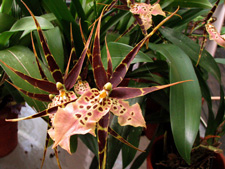Resource Library
Plant of the Week: Spider Orchid, Red
The University of Arkansas System Division of Agriculture does not promote, support or recommend plants featured in "Plant of the Week." Please consult your local Extension office for plants suitable for your region.
Plant of the Week
[A-Z]
Red Spider Orchid
Latin: x Miltassia shelob 'Red Spider'

Orchids attract me because of their beauty and exotic nature, but my record with growing them is pretty dismal. I'm a one-size-fits-all kind of caregiver and orchids just don't fit that mold. They have specific requirements, and if not given what they need they sulk and die. But there are exceptions. One that has bloomed for me several years in a row is a hybrid called x Miltassia shelob 'Red Spider.'
This beautiful orchid is a bigeneric hybrid between two South American orchids, Brassia 'Edvah Loo'and Miltonia 'Olmec'. Both are in the Oncidium alliance of the large orchid family. Many orchids are sexually compatible, a characteristic that would often result in plants being lumped together in one genus in other plants. But, because orchids often coevolved with a specific pollinator, the flowers of these sexually compatible plants may be strikingly different in appearance.
This Miltassia is a clumping epiphyte with smooth, thin, foot-long medium green leaves arising from smooth pseudobulbs. In a 6-inch pot plants can grow a foot wide and 16 inches high.
Blooms appear in warm weather, for me usually in June and July. The spikes usually contain six buds that open to 4-inch diameter spidery flowers. The light maroon-tinged, flattened lip is to 1.5-inch long with conspicuous dark maroon spots. Below it are five slender and tapered maroon tepals marked with bands of yellow. Individual flowers remain open for several weeks and, just before they wither away, they do turn reddish.
This orchid hybrid speaks of spiders. The Brassia side of the hybrid has spidery flowers with long, slender 6-inch long tepals that, in nature are pollinated by a wasp called the tarantula hawk. In a splendid example of co-evolutionary mimicry, this 2-inch long, orange-winged wasp sees the orchid flowers as spiders and, in the process of setting up to sting the flower, pushes its head into position to receive a dab of pollen. As the wasp visits other flowers cross-pollination is assured.
But the spidery allusion doesn't end there. The Shelob hybrids are named for the giant and evil spider that J.R.R. Tolkien brings to life high in the mountains on the border of Mordor in his “Lord of the Rings” volumes. A cultivar sold as 'Tolkien,' and certainly a sibling of 'Red Spider,' was hybridized in 1998 and received awards from the American Orchid Society in 2004.
The Shelob hybrids are vigorous and easy to grow by orchid standards. They are ephyphytic so must be grown in a coarse orchid bark mix. Because the pseudobulbs don't hold much moisture and the roots are fairly slender, the growing media should not be allowed to dry out between waterings. In the summertime, watering once every five to seven days seems adequate.
Fertilize with a liquid solution twice a month during the spring and summer when plants are making active growth. They should have bright light but not direct sun. Too much sunlight, even in the winter, can burn the thin, sword-shaped leaves.
Over winter plants can be kept in a cool greenhouse with nighttime temperatures between 45-50 degrees Fahrenheit. Or, if kept in the home, give them a bright windowsill location but protect the foliage from sunburn by means of a light curtain liner. Like most orchids, this species can go several years without division. But, when the pot becomes overly crowded with pseudobulbs, divide in the spring just before new growth starts.
By: Gerald Klingaman, retired
Extension Horticulturist - Ornamentals
Extension News - August 29, 2008
The University of Arkansas System Division of Agriculture does not maintain lists of retail outlets where these plants can be purchased. Please check your local nursery or other retail outlets to ask about the availability of these plants for your growing area.